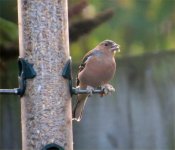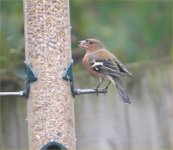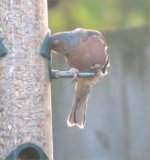-
Welcome to BirdForum, the internet's largest birding community with thousands of members from all over the world. The forums are dedicated to wild birds, birding, binoculars and equipment and all that goes with it.
Please register for an account to take part in the discussions in the forum, post your pictures in the gallery and more.
You are using an out of date browser. It may not display this or other websites correctly.
You should upgrade or use an alternative browser.
You should upgrade or use an alternative browser.
Chaffinch with Gloves? (1 Viewer)
- Thread starter BrianWH
- Start date
More options
Who Replied?
Hi Brian
Unfortunately this is a condition known as scaly leg, or bumblefoot. You can read more about these on the BTO website.
Unfortunately this is a condition known as scaly leg, or bumblefoot. You can read more about these on the BTO website.
stonechat1
New member
Sorry that I´ve to disagree. This are certain impacts of the papilloma virus and not caused by mites. Much more severe.Hi Brian
Unfortunately this is a condition known as scaly leg [...]
For more info read:
http://www.vri.cz/docs/vetmed/48-6-169.pdf
Iraq Babbler
Well-known member
Much more severe.
[/url]
Agree, and it is for sure not the same bird at all?
Omar
AlfArbuthnot
Well-known member
Hi Brian
Unfortunately this is a condition known as scaly leg, or bumblefoot. You can read more about these on the BTO website.
Scaly leg and bumblefoot and both two separate and different diseases, and the chaffinch has neither.
Scaly leg is a mite infestation only, bumblefoot is a bacterial infection of the ball of the foot, and the chaffinch has fringillae papillomavirus - a virus infection (that sometimes comes with a mite infestation).
Papillomavirus is spread by surface contact, so any other chaffinch coming to that feeder is likely to catch it, lose its legs, and die. If you see it, the ethical thing to do is take down the feeders. It's unfair to attract healthy birds onto the same perches that diseased birds are contaminating.
Edit: they're two different chaffinches in the picyures. They're probably already infecting each other around the feeders. Best to take them down.
They wont starve. It's autumn - there's plenty of natural food around.
Last edited:
BrianWH
Sparrowhawk
Whatever it is, it doesn't look good. I found this other picture that was taken at the same time. He appears to be standing on one leg, so perhaps the leg was painful?
I am very loath to take the feeder down, surely it could be disinfected instead. I don't know how long this bird has been coming, or whether it was his first visit.
I am very loath to take the feeder down, surely it could be disinfected instead. I don't know how long this bird has been coming, or whether it was his first visit.
Attachments
Last edited:

The trouble is with disinfecting, it will be reinfected at the next visit of the infected bird(s), so the advice to take it down till the bird is no longer around was very good and probably the best way to prevent the spread of the disease.
AlfArbuthnot
Well-known member
Whatever it is, it doesn't look good. I found this other pictures that was taken at the same time. He appears to be standing on one leg, so perhaps the leg was painful?
I am very loath to take the feeder down, surely it could be disinfected instead. I don't know how long this bird has been coming, or whether it was his first visit.
Why loathe to take them down? You have multiple diseased birds contaminating them. It's impossible to disinfect a feeder inbetween visits by each bird - as soon as one of the diseased chaffs comes back it will be contaminated again.
Birdfeeding is supposed to be helping birds, not spreading diseases that will give them a lingering death (their legs eventually fall off). There is plenty of natural food around, but at the moment you are attracting healthy birds to land on a feeder that will probably kill them.
When a hospital ward has an infectious outbreak, they close the ward. You need to do the same. Not to take that precaution is unethical and a bit selfish - these chaffinches are slowly dying. To be blunt, your feeder is killing them with kindness.
Valéry Schollaert
Respect animals, don't eat or wear their body or s
Brian,
I'm afraid Alf is very right. Please think of those poor things and remove your feeders some days. Thanks!
I'm afraid Alf is very right. Please think of those poor things and remove your feeders some days. Thanks!
JoeRawles
Feathers Wild Bird Care
To quote from the paper attached above:
The mode of transmission, current prevalence
of papillomavirus infections in chaffinches, bramblings, and other wild bird species, and effects of the infection on the fitness of the affected sub populations are unknown and deserve continuing attention.
Can't find much to say anywhere that it is spread through the feeders? Granted, if there is any time of year where it's ok to take your feeders down it is now, with plenty of natural food around they should be quiet anyway, but not sure on the evidence to suggest that taking them down will prevent the spread of this disease.
The mode of transmission, current prevalence
of papillomavirus infections in chaffinches, bramblings, and other wild bird species, and effects of the infection on the fitness of the affected sub populations are unknown and deserve continuing attention.
Can't find much to say anywhere that it is spread through the feeders? Granted, if there is any time of year where it's ok to take your feeders down it is now, with plenty of natural food around they should be quiet anyway, but not sure on the evidence to suggest that taking them down will prevent the spread of this disease.
Valéry Schollaert
Respect animals, don't eat or wear their body or s
Hi Joe,
You are right; however, sometimes looking for a definitive scientific proofs for everything make us losing our common sense somehow. Whatever the way they transmit to each other, concentrating the birds when a disease is there can only increase the risk of spreading.
When you have an unknown human disease around, do you stay home or rush in the middle of the crowd? :cat:
Cheers B
You are right; however, sometimes looking for a definitive scientific proofs for everything make us losing our common sense somehow. Whatever the way they transmit to each other, concentrating the birds when a disease is there can only increase the risk of spreading.
When you have an unknown human disease around, do you stay home or rush in the middle of the crowd? :cat:
Cheers B

It would seem sensible to take them down because (some) feeders by design, have limited access points for feeding and therefore are a concentration point for birds to stand on, thus transferring the disease to other birds. On trees, the food is more spread out and the chances of two birds landing in exactly the same spot it greatly reduced. It would be interesting to know if any studies concerning the (potential) increase in the occurence of the disease due to infected feeders have been carried out.
JoeRawles
Feathers Wild Bird Care
I can't disagree with your point Andy, in suggesting that feeders will concentrate birds in to one area, though the point is there is no evidence to suggest it's spread through feeders. As Valery says, as humans, if ill we often stay in, which is true but unfortunately a completely irrelevant point to make with regards to birds. My personal feeling, regardless of whether the feeders are a source of contamination or not, is that taking them in will make very little or no difference to the spread of this disease, but it is of course up to Brian to decide whether he feels it is necessary or not.
BrianWH
Sparrowhawk
To be blunt, your feeder is killing them with kindness.
I think that is a bit OTT, but point taken.
I have removed the feeders for a week or two, so you can all sleep easy. I probably wouldn't have seen that bird again but better safe than sorry I agree.
Valéry Schollaert
Respect animals, don't eat or wear their body or s
Thanks Brian.
You misunderstood me. I said that if you are healthy but outside you heard that there is a disease spreading, of unknown way of transmission, you perfectly know that staying home is safer than going in crowd...
Crowds are that best place to get a disease. Thus if there is a disease for birds, don't create crowds of birds. This is not science, this is common sense.
Right?
As Valery says, as humans, if ill we often stay in, which is true but unfortunately a completely irrelevant point to make with regards to birds.
You misunderstood me. I said that if you are healthy but outside you heard that there is a disease spreading, of unknown way of transmission, you perfectly know that staying home is safer than going in crowd...
Crowds are that best place to get a disease. Thus if there is a disease for birds, don't create crowds of birds. This is not science, this is common sense.
Right?
ChrisKten
It's true, I quite like Pigeons
If it makes you feel happier, Brain, then taking the feeders down was the right thing to do, but I can't see it making any positive difference in this case. Unless you can get all others in your local area to remove their feeders, as this bird is probably visiting their feeders as well. And if it wasn't before, it will be now your feeders have gone.
As Joe has said; there's no evidence that removing the feeders will affect the spread of this virus. Although there is a logical way of affecting the spread, and that's to remove this bird from the population. Either treat or euthanase it; suffering ended, virus spread limited.
That would be easier said than done of course, and removing the feeders makes us feel we are helping, whether we are or not is another matter.
(Although removing feeders might help for things like Salmonella, IMO, it still needs local cooperation to have any chance of doing any good, as your feeders might not be the source.)
I'm sure many will disagree with this post, but I'd be interested to hear evidence to contradict it, not opinion, evidence
EDIT: I've just read this back, and it doesn't quite come across as intended; I wanted to provoke a response/debate? but I didn't intend to sound like a troll. Please assume you can see a pleasant smile on my face while reading the above |=)|
As Joe has said; there's no evidence that removing the feeders will affect the spread of this virus. Although there is a logical way of affecting the spread, and that's to remove this bird from the population. Either treat or euthanase it; suffering ended, virus spread limited.
That would be easier said than done of course, and removing the feeders makes us feel we are helping, whether we are or not is another matter.
(Although removing feeders might help for things like Salmonella, IMO, it still needs local cooperation to have any chance of doing any good, as your feeders might not be the source.)
I'm sure many will disagree with this post, but I'd be interested to hear evidence to contradict it, not opinion, evidence
EDIT: I've just read this back, and it doesn't quite come across as intended; I wanted to provoke a response/debate? but I didn't intend to sound like a troll. Please assume you can see a pleasant smile on my face while reading the above |=)|
Last edited:
BrianWH
Sparrowhawk
If it makes you feel happier, Brain, then taking the feeders down was the right thing to do, but I can't see it making any positive difference in this case. Unless you can get all others in your local area to remove their feeders, as this bird is probably visiting their feeders as well. And if it wasn't before, it will be now your feeders have gone.
As Joe has said; there's no evidence that removing the feeders will affect the spread of this virus. Although there is a logical way of affecting the spread, and that's to remove this bird from the population. Either treat or euthanase it; suffering ended, virus spread limited.
That would be easier said than done of course, and removing the feeders makes us feel we are helping, whether we are or not is another matter.
(Although removing feeders might help for things like Salmonella, IMO, it still needs local cooperation to have any chance of doing any good, as your feeders might not be the source.)
|
Perhaps I should refit my feeders and when the bird visits again take a different kind of "shot at it", what do you think? |
Incidentally I have checked all my photos and this bird hasn't appeared before, when I have been looking anyway. All other birds photographed in my garden show no signs of the disease, so far.
I assume it is not a "reportable" disease?
claudio93
Member
Scaly leg and bumblefoot and both two separate and different diseases, and the chaffinch has neither.
Scaly leg is a mite infestation only, bumblefoot is a bacterial infection of the ball of the foot, and the chaffinch has fringillae papillomavirus - a virus infection (that sometimes comes with a mite infestation).
Can I ask you how to identify these different diseases??
During ringing activity sometimes we find Chaffinches like this, but we are always unsure if it's caused by mites or viruses...
JoeRawles
Feathers Wild Bird Care
Crowds are that best place to get a disease. Thus if there is a disease for birds, don't create crowds of birds. This is not science, this is common sense.
What I was trying to say was we can't control or create crowds of birds. I understand there is no evidence either way to say how it is spread, but whether you feed birds or not, that doesn't stop them feeding together elsewhere, they don't have the choice like we do to stay in. As Chris said, the birds will either move on to other gardens for food or forage elsewhere, particularly with species such as Chaffinch (and Greenfinches in the case of Tricho) which are gregarious birds, they will feed in groups wherever they go.
As with Chris, I'm not here to spark an argument, but merely here to post my opinion! At the end of the day, nature is something we will never properly understand, but should simply admire.
Users who are viewing this thread
Total: 2 (members: 0, guests: 2)






